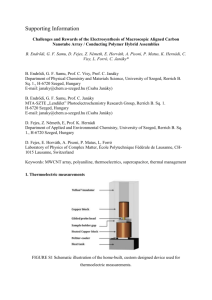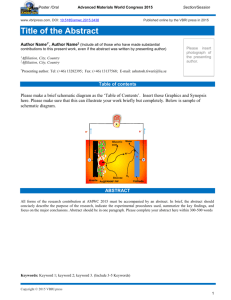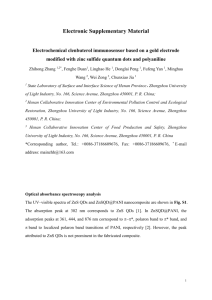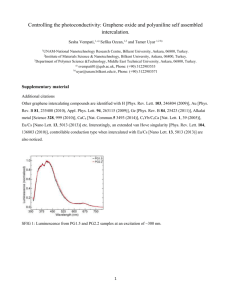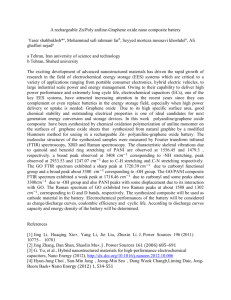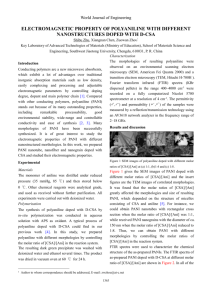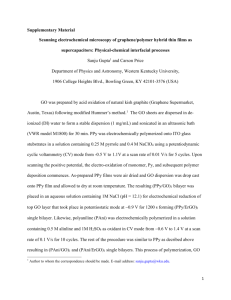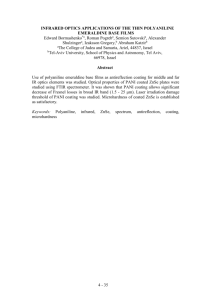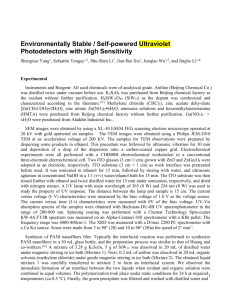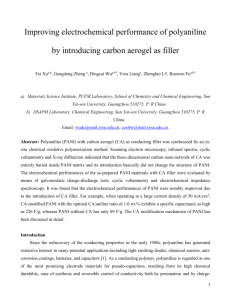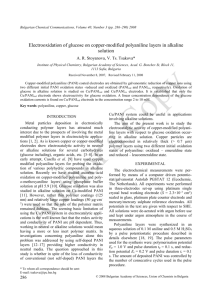Supplementary_revised_APL
advertisement
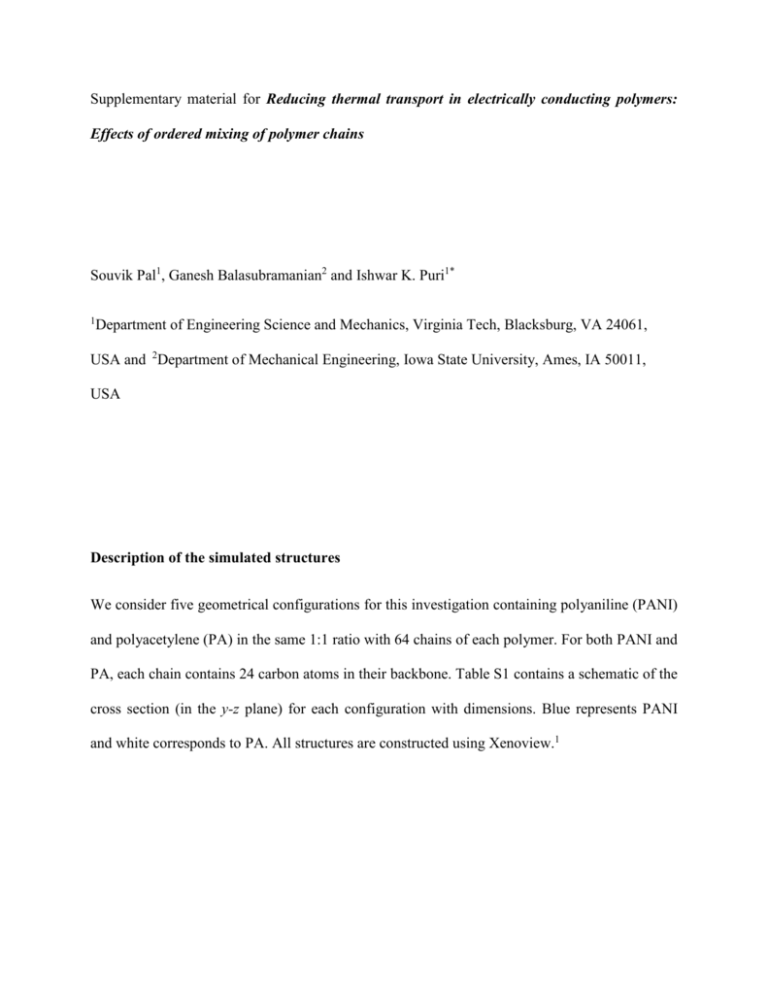
Supplementary material for Reducing thermal transport in electrically conducting polymers: Effects of ordered mixing of polymer chains Souvik Pal1, Ganesh Balasubramanian2 and Ishwar K. Puri1* 1 Department of Engineering Science and Mechanics, Virginia Tech, Blacksburg, VA 24061, USA and 2Department of Mechanical Engineering, Iowa State University, Ames, IA 50011, USA Description of the simulated structures We consider five geometrical configurations for this investigation containing polyaniline (PANI) and polyacetylene (PA) in the same 1:1 ratio with 64 chains of each polymer. For both PANI and PA, each chain contains 24 carbon atoms in their backbone. Table S1 contains a schematic of the cross section (in the y-z plane) for each configuration with dimensions. Blue represents PANI and white corresponds to PA. All structures are constructed using Xenoview.1 Table S1 Configuration Cross-section in yz plane Length along x (heat Volume(Å3) transfer) direction X (Å) Y / 2 PANI 1. PA Z 37.46 Å 44.75 73272 44.83 74527 44.28 76322 41.95 73171 43.12 73173 Y 43.71Å 5Å 5Å PANI 2. Z 33.97 Å PA Y 44.23 Å 5Å 5Å 3. PA Z 33.27 Å PANI Y 43.44 Å Y 3 PANI 4. PA PANI PANI Z 2 PA PANI Z 37.96 Å PA Y 45.95 Å PANI PA 5. PANI Y 47.23 Å Z 35.93 Å Interfacial area The interfacial area S is the area of the contact surfaces across which the polymers interact. From the y-z plane cross section the length of the interface is calculated, which is then multiplied by the length of the configuration along x-wise direction ( X ) to obtain the total interfacial area. If the interface between PANI and PA is smooth, as shown in Fig. S1(a), its length Z can be marked by the dotted line. Thus, the total interfacial length for configuration 1 is 2Z accounting for the periodic boundary conditions, i.e., S = 2Z X . Y / 2 PANI PA Z 37.46 Å Y 43.71Å Figure S1: The schematic for calculation of interfacial area for configuration 1. Modification of interfacial area calculation for distorted interface Due to the movement of the PANI and PA atoms during thermal equilibration, the interface becomes distorted so that it is no longer a regular straight line, as illustrated in Fig. S1. Therefore, a more accurate measure of S is obtained using an image analysis code.2 Figure S2 contains an actual image for configuration 1 following thermal equilibration at 300 K. The interface is identified in the figure and its length is measured by the code after proper calibration. PANI PANI PA PA Z 37.46 Å Y 43.71Å Figure S2: Image of the interface obtained from the simulation of configuration 1 after equilibration at 300 K. Calculation of interfacial area for random distribution (configuration 5) of polymer chains For configuration 5, the PANI and PA molecules are distributed randomly throughout the crosssection. No well-defined interfaces can be identified through the cross sectional view. This makes the process of outlining the interface and calculating its total length both tedious and inaccurate. To circumvent this problem, the image processing functions in MATLAB (version R2012a 7.14.0.739) are used. Figure S3(a) shows the cross-section of configuration 5 from a simulation image after equilibration at 300 K. The corresponding grayscale binary image is presented in Fig. S3(b). Using the Prewitt edge detection algorithm in MATLAB,3 the interface is detected as illustrated in Fig S3(c). The total interface length is obtained by counting the number of white pixels in Fig. S3(c) and comparing it with the magnitude of the image dimensions in pixels. Unlike the image analysis approach described in Fig. S2, this approach involves tedious image pre-processing for MATLAB to produce meaningful results. So the image analysis code2 is used for configurations 1 to 4 for convenience. PA PA PA PANI PANI (a) (b) PANI (c) Figure S3: Cross section (y-z plane) view of configuration 5 with a random distribution of PANI and PA a) A simulation image obtained after equilibration at 300 K. b) The corresponding grayscale binary image in MATLAB c) Detected edges from Fig. S3(b) using the Prewitt edge detection algorithm in MATLAB,3 represented by white lines. Energy minimization Energy minimization for all configurations is performed using the conjugate gradient technique. The convergence of energy with respect to subsequent iterations for a representative simulation for configuration 1 is shown in Fig. S4. This convergence is similar to that obtained for all other configurations. Since we perform velocity initialization (i.e., assign initial velocities corresponding to the desired temperature to individual atoms in the configuration) only after minimization, the kinetic energy is zero. Hence, the energy plotted in Fig. S4 is essentially the potential energy of the configuration. The minimization process runs until it satisfies the convergence criterion (En - En-1 ) / En-1 £ 10-6 , where, En and En1 are the energies at the n and n 1 iterations. For configuration 1 being discussed, convergence occurred after 913 iterations. Energy (kJ mole-1-1) ) 225000 205000 185000 165000 145000 125000 105000 0 200 400 600 Iterations 800 1000 Figure S4: The convergence of the energy to a minimum during a representative energy minimization simulation for configuration 1. Details of equilibration After energy minimization, each configuration is initialized at the simulation temperature (150, 200, 250, 300, 350 and 400 K for the different cases) followed by a two-step process of annealing and tempering, and a three-stage equilibration process under NPT-NVT-NVE ensembles, each for 0.2 nanoseconds as detailed in the main manuscript. To check if a configuration is properly equilibrated, the temperature during the final (NVE) stage is tracked over time. For the first two stages (NPT and NVT), the temperature is held constant. Proper equilibration ensures that temperature also remains constant during the following NVE stage. Figure S5 shows the temperature of configuration 1 during the 0.2 nanoseconds long NVE stage after the NPT and NVT stage at 300 K. The temperature fluctuates around a time-averaged value of 299 K with small deviations (that have a maximum magnitude of ±0.76 % from the time averaged value). This indicates that a steady state has been reached and a properly equilibrated structure has been obtained. Temperature (K) 310 300 290 280 270 260 250 0 0.05 0.1 Time (ns) 0.15 0.2 Figure S5: The variation in temperature for configuration 1 over time during the NVE stage after completing the NPT and NVT stages for a constant temperature of 300 K. Reference 1 2 S. Shenogin and R. Ozisik, Polymer 46 (12), 4397 (2005). Connected Mathematics Project, (2006) Areas and Perimeters [Applet], CMP Interactive Resources Grade 6, http://connectedmath.msu.edu/CD/Grid/index.html (September 27, 2012). 3 J. M. S. Prewitt, in Picture Processing and Psychopictorics, edited by B. S. Lipkin, A. Rosenfeld (Academic Press, New York, 1970).
